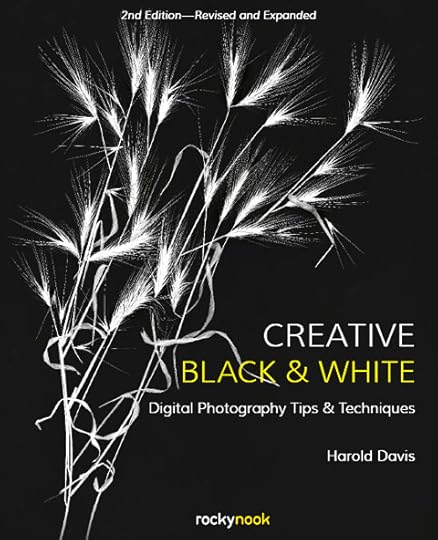Harold Davis's Blog, page 65
August 6, 2019
From O’Keeffe to Blossfeldt…or, is it a Davis photo?
I’ve long been tickled to find my Kiss from a Rose attributed as a Georgia O’Keeffe painting. To be clear: tickled for my work to be confused with the great artist O’Keeffe, but way less than thrilled to have my image used all over Pinterest and other websites without correct attribution (that would be to me!), permission, license, or fee.

Kiss from a Rose © Harold Davis
Karl Blossfeldt (1865-1932) was a great German botanical photographer. In my new book, Creative Black & White 2nd Edition, I included a section on simulating the “Karl Blossfeldt effect” using digital monochromatic post-production techniques.
Recently, I found that a major European art publisher and distributor was selling an image of mine (shown below) as a Blossfeldt image, and has included my image in a catalog page of Blossfeldt imagery. Once again I am subject to competing emotions: honored to have my work mistaken for one of my photographic heroes, but outraged that my work has been pirated without attribution, permission, license, or fee for someone else’s profit. What were they thinking? Did they not read my copyright notice?

Queen Anne’s Lace © Harold Davis

August 4, 2019
Now open for registration: 2020 Flowers for Transparency Workshop
We are pleased to announce the 2020 session of Photographing Flowers for Transparency with Harold Davis (June 20-21, 2020) to be held in Berkeley, CA. Click here for more information, and here for registration, or contact us for information or registration.

August 1, 2019
Now You See: Two Pods and a Bee
Yesterday I photographed at a local garden, and came back with images of a bee, and two flowers gone to seed. I used the Lensbaby Velvet 85mm f/1.8 for each of these images.

Bee the Light © Harold Davis

Seed Head © Harold Davis
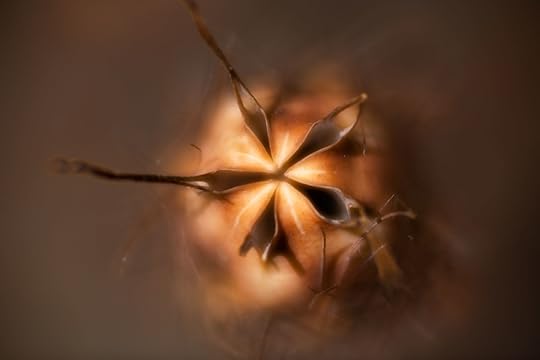
Seed Head 2 (color) © Harold Davis

LAB Color Variations
From the block-print-like flower composition on white (shown second from the bottom of this story), I used LAB color to apply individual color channel adjustments to create the eight variations shown in the Photoshop collage (immediately below). To learn how to do this in detail and step-by-step, check out my complete online video training course Creative LAB Training in Photoshop. This course provides unique and detailed information, substantially the result of years of research, work, and experimentation on my part, that you can find nowhere else.

Collage showing LAB Flower variations © Harold Davis
I created the original version shown below using my Photographing Flowers for Transparency technique on a light box. The channel adjustments in the collage (above) use variations that do not involve inversions of the L-channel, which swap whites for blacks (and blacks for whites), and (in this case) create a black background effect. An example of an L-channel inversion of the block-print flower image is shown at the bottom of this story.

Flower Block on White © Harold Davis
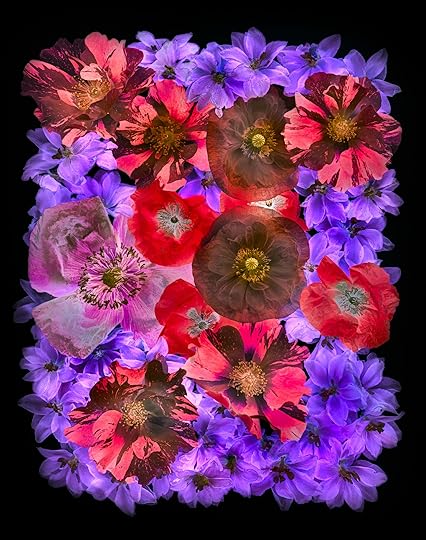
Flower Block L-Channel Inversion © Harold Davis

July 31, 2019
My Photoshop Courses Now Available for Standalone Purchase
I am pleased to be able to offer my Creative LAB Color in Photoshop and Photoshop Backgrounds & Textures courses for standalone purchase. Each course costs $44.99.
The courses are available from LinkedIn Learning. As I noted, you can buy my courses individually; alternatively, you can still subscribe to the entire platform of LinkedIn courses (not just my LinkedIn Learning courses). The subscription is really a pretty good deal: you get the first month free (and can cancel at any point), and with the wealth of Photoshop course offerings it is a great way to hone your Photoshop skills. Here’s some more information about my courses!
Photoshop Backgrounds & Textures
Click here to buy or view my course on LinkedIn Learning.

Poem of the Road © Harold Davis (as shown in the course, this image uses two texture files)
Course Description:
Turn the ordinary into the extraordinary. Learn how to transform relatively straightforward photographs into distinctive visual art, using Photoshop backgrounds and textures.
In this course, photographer and digital darkroom expert Harold Davis walks through the technical specifics of adding backgrounds and textures to your Photoshop compositions, and provides the inspiration and resources you need to get fantastic results.
Learn how to provide context and “frames” with backgrounds, and use textures as nondestructive overlays to enhance the look and feel of your images. Harold shows how to use scans and photos of found objects as the basis for custom textures, and even license textures from commercial libraries.
Plus, discover a post-production workflow for the iPhone that maximizes your flexibility, mobility, and creativity, and explore four iOS apps that Harold recommends for iPhone photography.
Topics Include:
Using blending modes, masks, and selections to build backgrounds
Creating and sourcing backgrounds
Creating effects with textures
Adding textures to portraits and landscapes
Licensing textures
Creating texture-based effects on the iPhone
Duration: 2h 18m
Click here to view my course on LinkedIn Learning. There is a free preview. The full course is behind the paywall, but note that a free trial subscription is available for one month. Alternatively, you can buy my course as a standalone.
Creative LAB Color
Click here to view or buy my course on LinkedIn Learning. Here’s a preview:
Photoshop: Creative Lab Color by Harold Davis
Course Description:
Explore the tools, techniques, and creative possibilities of Lab Color in Adobe Photoshop. Lab opens new opportunities for photo enhancement and creative image making, enabling you to apply contrast, sharpening, inversion, and equalization adjustments to individual LAB channels. If you want more exciting images, it’s time to explore Lab Color. In this course, Harold Davis explains how Lab compares to other color spaces and how it is implemented in Photoshop. He walks through his own professional post-production workflow for enhancing and transforming images with Lab Color. Then learn how to use Lab for more creative fun and image-making prowess with Harold’s custom Photoshop Lab action, color channels, and blending modes. Plus, learn how to leverage images in Lab for pattern making and surface design.
Topics Include:
Converting images to Lab Color space
Applying Curves to Lab channels
Selective sharpening
Inverting channels
Making per-channel equalizations
Using the Lab action
Combining Lab Color with blending modes
Making patterns with Lab images
Click here to view or buy my course on LinkedIn Learning.

July 29, 2019
Stuff
As George Carlin put it in one of his most memorable routines, a house is nothing put a pile of stuff with a cover on it. In contrast, I suppose a home might be something more important than the mere stuff in a house, having to do with where the heart is. Since a home is where the heart is, it is transportable: your home is where ever your family and those you love are.
In any case, love stuff or hate it, we all seem to gather it. Here are two photos, and one variation, of some of the stuff in my house, made with a macro lens on a black background of some of our stuff. The first image shows flowers from my garden that have been drying for a while, along with shells, lichen, a sea horse, and a blue jay feather I found on a walk the other day.
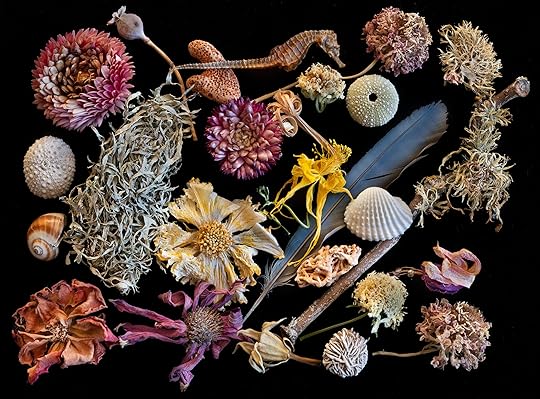
Collection © Harold Davis
The next image is of a pile of elastic bands, specifically, rubber elastic bands used to keep hair under control. I’ve been telling Phyllis I would photograph these for years, and somehow she never believed I really would. Finally (far below) I made an LAB adjustment in Photoshop, by equalizing the L-channel, of the elastic band image, with somewhat surprising results.

Elastic Bands © Harold Davis

Elastic Bands – L-channel Equalization © Harold Davis

July 27, 2019
Playing with Lilies
There’s nothing like a carpet of oriental lilies on my light box for photographic fun! Shown here with a few petunias, roses, and jasmine blooms to round out the prevailing pink. An L-channel LAB inversion, putting the image on a black background, is shown below.

At Play with Lilies © Harold Davis

At Play with Lilies Inversion © Harold Davis

July 26, 2019
Creative Black and White 2 Ed (and Discount Code!)
I’m very pleased that my new book, Creative Black & White, 2nd Edition, is now available. The publisher, Rocky Nook, is offering a 40% discount. Click here to buy Creative Black & White 2nd Ed directly from the publisher. Use the code “HDAVIS40” [no quotes] at checkout to apply the discount (you can also use my discount code for all other Rocky Nook books, by the way!).
Here are the links for my book on Amazon.com and on B&N as well, so the choice of supplier is yours.
If you like Creative Black & White, 2nd Edition, I would really appreciate a thoughtful review. Thanks!
Creative Black & White has been revised, substantially expanded, and brought up to date. I’ve added entire sections, substantially enlarged the book (it is 80 pages longer than the first edition), and most of the photos are new. Every photo includes information about how it was made, both from a technical perspective, and also the story about my thinking behind the image.
Click here to buy my book from Rocky Nook (please use the HDAVIS40 discount code for your discount), here for my book on Amazon, and here on Barnes & Noble.

July 25, 2019
Mallow and Friends
I like the way this light box image, never before blogged, shows the translucency of the rose petals with the mallow coming through, diffracted but loud and clear!
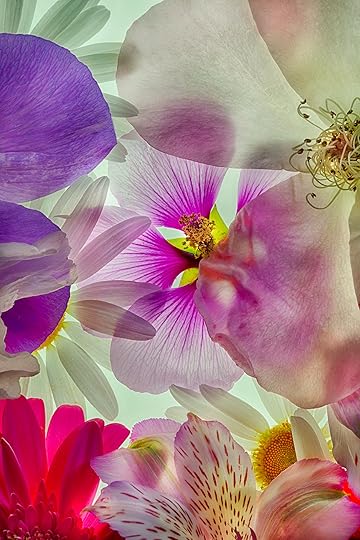
Mallow and Friends © Harold Davis

The Story of a Cactus Flower
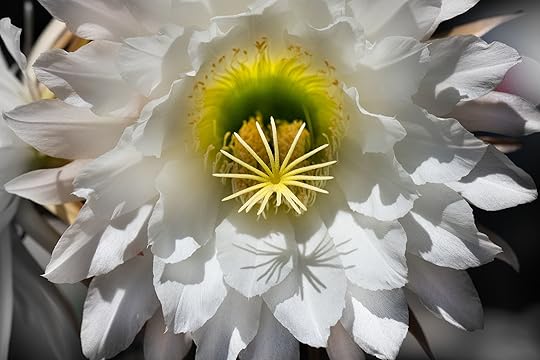
Cactus Flower © Harold Davis
Phyllis told me she saw a giant cactus flower at about camera height near the small shopping area of Kensington, California about 1/2 mile from our house when she passed through the Kensington strip in the morning. So I went up with my gear, and in a small, arid strip next to a parking lot there was indeed a barrel cactus, possibly a Ferocactus cylindraceus, with a large, white flower. The cactus seemed to be nestling in the shade of a Yucca, also in bloom and dripping sap. The flower was perhaps a foot in diameter with a yellow center (see photo above) and exuding a strong, pungent odor.
I had hoped to use my tripod, but there was a fierce wind blowing the petals of the flower, hence no real point to the tripod. Most of the images shown in this story were made with my 150mm Iris ‘Dragonfly’ macro hand-held, with the aperture pretty close to wide open (f/2.8).
My thought was to come back in a few hours in the early evening, when the light would be softer, and perhaps the wind would have died down. But when I got back, the bloom was off the cactus. This indeed is an illustration of the ephemeral nature of beauty: the flower had a lifespan of less than a day.

Cactus Flower Detail I © Harold Davis

Cactus Flower Detail II © Harold Davis

Cactus Flower Detail III © Harold Davis
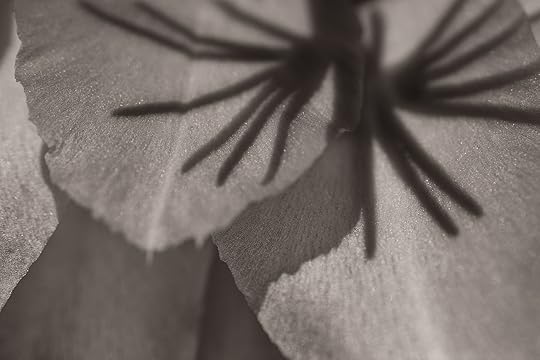
Cactus Flower Detail IV © Harold Davis
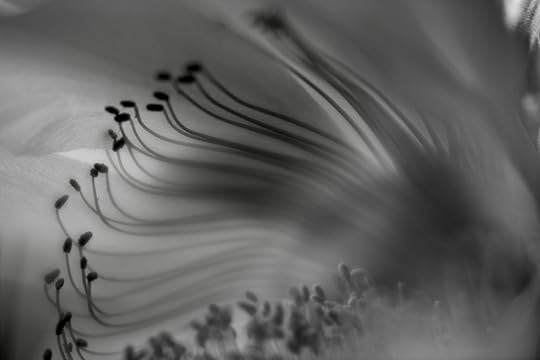
Cactus Flower Detail V © Harold Davis



